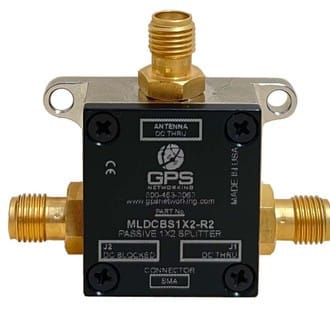High precision Global Positioning System (GPS) navigation and testing applications often call for the use of multiple receivers processing the signal from a single antenna. To send a single input to multiple outputs, a GPS splitter is required. Using a splitter allows the user to save time and money by not installing multiple antennas.
These splitters vary as widely in design and function as the applications they network. Large, rack mount splitters, such as the GPS Networking NRMALDCBS1X32, can split a single antenna input to 2 to 32 receivers at once while amplifying that signal to compensate for line loss. Additionally, Splitters can be chained together to provide further outputs. These splitters are ideal for laboratory environments and other indoor applications where precision is needed. Smaller, passive splitters, such as the GPS Networking MLDCBS1X2-R2 (pictured above), can split a signal to two receivers in Cost, Size, Weight, and Power (cSWaP) constrained applications such as drones and robotics.
What is the benefit of highly specialized splitters?
High precision GPS applications range from small, high velocity vehicles that require reliable, real-time positioning to surveying, telecom, reference and timing receivers, and testing, where precise results can be obtained with high grade equipment. These applications come with a variety of challenges, all of which are addressed through the options available in GPS splitters.
At a glance, the most obvious variations in splitters are the size of the splitter and the number of outputs. Applications with higher payloads can generally support a larger, heavier splitter and may benefit from the ability to scale up the number of receiver outputs. These size differences can be dramatic, with the GPS mini splitter weighing less than 30 grams (0.066 lbs.) and the rack mount splitter weighing approximately 7 kilograms (15.43 lbs.). The mini has only two outputs while a rack mount has 8, 16 or 32 outputs.
Another obvious difference is the connector type. GPS antennas and receivers do not use a standardized connector. For compatibility, splitters are available with a variety of connectors such as SMA, BNC, N-type, TNC, and more. Cables will complete the connection from the splitter to receiver and can be converted to any type of RF connector at that point.
Power is a critical consideration in most applications. Externally powering the splitter, independent of the GPS receiver is available in AC or DC sources. External power increases the size, weight, and cost of the splitter but prevents the splitter from being a burden on the receiver’s limited power. Further, if the receiver which is powering the splitter fails or is disconnected the rest of the system will stop working. External power allows for a backed up, independent source for the entire system.
Where cable length causes significant line loss, an active splitter ensures that a sufficiently powerful signal arrives at the receiver. Without amplification, the relatively weak signal from a GPS satellite can become lost in noise. For exceptionally long cable runs and for secured applications we can also provide a fiber optic solution between the antenna and splitter or receiver.
Splitters exposed to the elements can be compromised by water, dust, and other foreign substances. Weatherproofing and airtight hermetic sealing are available on many splitters, making them more robust and reliable in harsh conditions.
The internal signals of the splitter can interfere with one another, degrading the accuracy of the system. For applications where minimizing signal variation is critical, high-isolation splitters can prevent such interference within the splitter itself.
These features and variations can be mission critical but can add to the size, weight, power consumption, and cost of the splitter. The incredible diversity of GPS applications requires combinations of of these features and options to optimize available resources.
NavtechGPS has been designing GNSS networking systems for over 20 years and has the experience to design a system for your specific environment.
